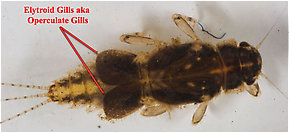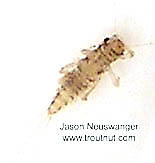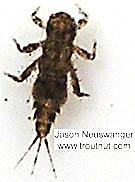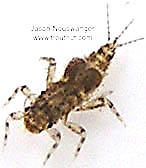Blog & Latest Updates
Fly Fishing Articles
Insects by Common Name


Mayfly Genus Caenis (Angler's Curses)
Taxonomic Navigation -?-
Kingdom
Animalia (Animals)
» Phylum
Arthropoda (Arthropods)
» Class
Insecta (Insects)
» Order
Ephemeroptera (Mayflies)
» Family
Caenidae (Angler's Curses)
» Genus Caenis (Angler's Curses)
| Species in Caenis | ||
| Caenis amicaAngler's Curse | 0 | 0 |
| Caenis hilarisAngler's Curse | 0 | 0 |
| Caenis latipennisAngler's Curse | 0 | 0 |
| Caenis tardataAngler's Curse | 0 | 0 |
| Caenis youngiAngler's Curse | 0 | 0 |
7 species aren't included.
Common Names
They very rarely elicit selective feeding, but when they do they're very tough to match because they're often much smaller than size 28. This difficulty has earned them the nickname "Angler's Curse."
Where & When
Time Of Year (?): June through early September; best in June and July
Preferred Waters: Rivers and lakes
Most Caenis mayflies emerge in the evenings when other, larger mayflies are abundant on the water. This limits their importance.Preferred Waters: Rivers and lakes
Hatching Behavior
Caenis mayflies typically emerge, molt into spinners, mate, and oviposit within one hour.
Nymph Biology
Substrate: Silt, weeds
Every book says pools and stagnant back-waters are the prime habitats of these nymphs. This is probably true, but I have often found them in gravel, vegetation, and other habitats. They have operculate (
The operculate gills of a Caenis nymph.
Pictures of 11 Mayfly Specimens in the Genus Caenis:
Caenis (Angler's Curses) Mayfly Nymph View 4 PicturesI confirmed the identity of this nymph by looking at it under a microscope to be certain of the shape of its gills and head.
View 4 PicturesI confirmed the identity of this nymph by looking at it under a microscope to be certain of the shape of its gills and head.
 View 4 PicturesI confirmed the identity of this nymph by looking at it under a microscope to be certain of the shape of its gills and head.
View 4 PicturesI confirmed the identity of this nymph by looking at it under a microscope to be certain of the shape of its gills and head.Collected January 31, 2004 from unknown in Wisconsin
Added to Troutnut.com by Troutnut on January 25, 2006
Added to Troutnut.com by Troutnut on January 25, 2006
Caenis (Angler's Curses) Mayfly Nymph View 3 PicturesThis interesting little Caenis nymph is way darker than any of the others I collected in January 2004, probably a different species. It also has shorter tails.
View 3 PicturesThis interesting little Caenis nymph is way darker than any of the others I collected in January 2004, probably a different species. It also has shorter tails.
 View 3 PicturesThis interesting little Caenis nymph is way darker than any of the others I collected in January 2004, probably a different species. It also has shorter tails.
View 3 PicturesThis interesting little Caenis nymph is way darker than any of the others I collected in January 2004, probably a different species. It also has shorter tails.Collected January 31, 2004 from unknown in Wisconsin
Added to Troutnut.com by Troutnut on January 25, 2006
Added to Troutnut.com by Troutnut on January 25, 2006
Caenis (Angler's Curses) Mayfly Nymph View 3 Pictures
View 3 Pictures
 View 3 Pictures
View 3 PicturesCollected February 7, 2004 from unknown in Wisconsin
Added to Troutnut.com by Troutnut on January 25, 2006
Added to Troutnut.com by Troutnut on January 25, 2006
Your Thoughts On Caenis:
Top 10 Fly Hatches
Top Gift Shop Designs
Eat mayflies.
Top Insect Specimens
Miscellaneous Sites
Troutnut.com is copyright © 2004-2024 Jason
Neuswanger (email Jason). See my FAQ for information about use of my images.
 privacy policy
privacy policy
